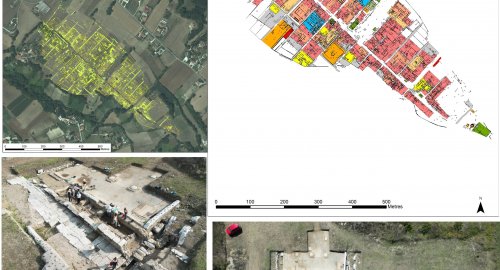
Ancient Lost City that withstood the Decline of the Roman Empire discovered in Italy

- 13-12-2023, 08:59
INA- SOURCES
For centuries, the town of Interamna Lirenas in central Italy was thought to be an unremarkable backwater that declined after the fall of the Roman Empire. However, recent archaeological excavations by a team from the University of Cambridge have uncovered startling new evidence that challenges our understanding of life in Roman Italy.
What was once dismissed as an unimportant site with little archaeological potential has revealed itself to be a thriving urban centre that defied expectations of decline for hundreds of years longer than previously believed.
Through careful excavation and the latest geophysical surveying techniques, the researchers have mapped the entire layout of the town, uncovering impressive structures like markets, warehouses, bath complexes and even a rare roofed theatre.
These discoveries show that Interamna Lirenas was far from a failure – it adapted brilliantly to challenges over nearly 900 years of occupation.
The extensive survey work allowed the archaeologists to systematically study the site without disrupting open farmland. Mapping revealed a densely occupied town covering around 60 acres at its peak when it was home to an estimated 2,000 people.
Distribution of common cooking pots helped date periods of habitation more accurately than previous studies relying on imported fine pottery.
It showed the town resisted decline until the 3rd century AD, some 300 years later than believed. This indicates populations in Roman Italy may have been more resilient than the assumption of widespread decline in this era.
One reason for Interamna Lirenas’ success was its strategic location on the River Liri, a prime spot for trade and transport between important inland centres.
Evidence of large warehouses, temples and baths uncovered near the river point to a bustling port serving the town’s commercial interests. Its position along major roads also appealed to Roman leaders – the ruins of an inscription confirm the town received patronage from Julius Caesar himself in 46 BC.
However, this alone did not ensure long-term prosperity – the archaeologists believe the town thrived through continually adapting to changes over many centuries.
Another surprising discovery was an impressive roofed theatre, a rare and costly structure that could seat 1,500 people. The presence of such a major public buildingchallenges the idea that Interamna Lirenas declined, as theatres usually imply civic pride and wealth.
Traces of renovation and inscriptions honouring benefactors show it remained in active use well into later Roman times. Elsewhere, the archaeologists found densely packed housing without segregation by class, multiple functional courtyard buildings thought to be markets and warehouses, and evidence of thriving wool production.
Despite facing many threats like invasions, the town seemed to have been gradually abandoned sometime before the 6th century AD due to growing insecurity on major travel routes rather than a sudden violent destruction.
The resilient people of Interamna Lirenas likely chose to relocate preemptively to safer areas rather than wait for danger. Their lengthy occupation inspires modern residents of nearby Pignataro Interamna, who have renamed a local café after a sundial uncovered at the site.
Through diligent archaeological work integrating the latest techniques, this project has revolutionised our picture of everyday life in Roman Italy during a period often characterised as one of decline.
Interamna Lirenas proves communities found ways to adapt and prosper for centuries longer than historians expected. Its story of resilience over nearly a millennium challenges widespread assumptions and encourages re-examination of other supposedly insignificant sites across the Roman world.
SDOURCE: La brujula Verde
First joint picture of Greenland Ice Sheet melting, ESA
- Multimedia
- 09:28
US Central Command: We killed ISIS terrorist leader Abu Yusuf in Syria
- International
- 24/12/20
Liverpool compete with Real Madrid to sign Olympique Lyonnais star
- Security
- 24/12/19
ISC, ADX discuss Strengthening Economic Ties
- Economy
- 24/12/16
Iraq assumes presidency of Arab Investment Company’s Executive Board
- Economy
- 24/12/17












